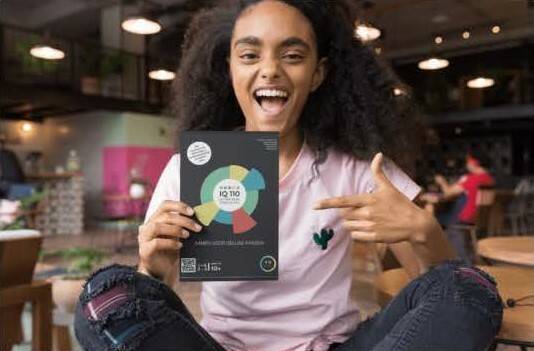Project Summary and Context
Promoting inclusive school cultures and, more specifically, addressing inequality of opportunity is high on the European education agenda. This is reflected in the policies and ambitions of many teacher training institutes. As inequality is part of a ‘wicked problem’, simply adding the theme to the curriculum is hardly a solution. Equipping teachers to be able to identify and address inequality of opportunity requires them to develop sensitivity, multi-perspectivity and agency, for instance, and these are complex attributes that require personal experiences and deep reflection.
Recognizing this complexity, five master’s students chose this challenge for their collective graduate research project. Following the principles of design research, they developed a game that helps both beginning and experienced teachers reflect on the hidden mechanisms of inequality, particularly on the effects of socio-economic status (SES), and it stimulates them to address these mechanisms. In the card game, that is played by 3-5 teachers, each teacher first draws a persona card; each player ‘becomes’ a pupil with a given SES-background, and then gathers positive and negative experiences.
This article reports on the impact of the game – both in terms of outcomes and in its driving mechanisms. To this end, the canvasses on which the individual participants recorded their learning outcomes were analyzed, as well as a retrospective questionnaire that was administered. The respondents (n = 90) were students in either initial teacher training programmes or post initial (master’s) programmes.
The results are promising, especially on (a) identifying with low SES pupils and (b) feeling the accumulation of negative experiences which raises teachers’ awareness. The participants report that through the individual and collective reflections afterwards, they are better equipped to understand and address the issue.
Introduction: Inequality of Opportunity is Back on the Agenda
Inequality of opportunity is a growing problem in the Netherlands (OECD, 2022; Dutch Inspectorate, 2021; Onderwijsraad, 2021), and schools struggle to address the issue. Elffers (2022) argues that for decades, Michael Young’s (1958) ideas on a merit driven society have been a driving force towards a society in which one’s background is not the determinant of one’s destination, but rather IQ and effort make the determination. Young’s ideas point to an education system being seen as ‘the great equalizer’ (e.g., Downey, von Hippel, & Broh, 2004). In pursuit of ‘meritocracy’ there has been a great increase in the number of people that have pursued higher education, and in the Netherlands more people than ever before have school certificates, diplomas and degrees. Elffers (2022) argues that, paradoxically, this situation has now led to new forms of inequality. Jansen, Elffers, and Jak (2021) explain that in a market driven world where everybody gets an education – striving for equality has generated new forms of competition. Parents with high socio-economic status have the means to support their children to be a little more equal than others (Elffers, 2019). Because of this, education is no longer necessarily the place where differences are eliminated. Moreover, the diversity in (and outside) today’s classrooms has increased (Eurostat, 2021), and consequently, so have reported differences in opportunity. The SER (2021) – the Dutch Socio-Economic Council – reports that the COVID crisis magnified these differences, and as a result inequality is back on the agenda, and it poses great challenges for schools.
Can schools compensate for society?
A much quoted (and often misrepresented – see e.g., Pavet, 2014) article on the role of education with regard to inequality of opportunity is Bernstein’s (1970) Schools cannot compensate for society. Bernstein explains that the notion of compensation is problematic if it “serves to direct attention away from the internal organization and the educational context of the school, and focuses on the families and the children” (p. 344). If pupils are seen as deprived, he argues “teachers will have lower expectations of the children, which the children will undoubtedly fulfil.” The paradox here is that if teachers do not take their pupils’ backgrounds into consideration, that too can lead to inequality of opportunity (Cobb, 2017).
Bernstein’s ideas are often compared to Bourdieu’s concept of habitus (e.g., Harker & May, 1993). Bourdieu (1986; 1990) explains differences in opportunity in terms of how economic, social, and cultural capitals are allocated as different types of resources. If few of these capitals are accumulated in the home situation, not only is a child’s starting position in school compromised, but the child also misses the very instruments with which to accumulate such capitals. Or, in the words of Ready (2011, p. 2), “…the far greater cultural and economic assets of the privileged in society, is culturally and educationally accumulated in the middle and upper classes, not because they are naturally more intelligent but because they have more resources to enable that accumulation.” Overall, this means that the inequality of opportunity increases, not just over the course of a child’s school career, but also after that.
A similar outcome is explained through the accumulation model (e.g., Benzeval et al., 2014): the accumulation of adverse childhood experiences – sometimes referred to as ACEs – can negatively affect opportunity and even health (Edwards, Gillies, & White, 2019). Whereas schools may not be able to change or fully compensate for ACEs that children accumulate outside of school, they should at least make sure school itself is a safe environment where differences are not magnified, and the accumulation of ACEs is at least slowed. Or in the words of Reay (2011, p.1), we “need to create educational systems that reduce the social distance between people rather than, as the current systems do, exacerbate them.”
Promoting such inclusive school cultures is high on the European education agenda (e.g., European Commission, 2020). This is reflected in the policies and ambitions of many teacher training institutes. As inequality is a complex issue (see e.g., Keep & Mayhew, 2014), simply adding the theme of equality/inequality to the curriculum is hardly a solution. Equipping teachers to be able to identify and address inequality of opportunity requires them to develop sensitivity, multi-perspectivity and agency, for instance, and these are complex attributes that require personal experiences and deep reflection (Goei et al., 2021).
IQ110 – an exceptionally unfair game
Recognizing this complexity, five master’s students chose this challenge for their collective graduate project. Dymphna, Mavis, Sanne, Sharon and Wybe were all experienced teachers in either primary, secondary, vocational or higher education. Part of their challenge was to find a way to engage their beginning and experienced colleague teachers to become more sensitive to their pupils’ backgrounds. Oplatka and Gamerman (2021), who conducted research on the element of compassion in urban education, argue that to this end, a teacher ideally “takes into account the student’s personal and social position, respects his or her personality and identity, empowers the student, and increases the student’s self-esteem and encourages constructive behaviors in the class” (p. 324). The first step to such compassion is identification, they claim.
In educational settings, a promising way to facilitate the process of identification is through gamification (Faiella & Ricciardi, 2015; Foster & Shah, 2020). Zainuddin et al. (2020) discuss how, in game-based learning, connections between social comparison and competitiveness can be furnished, which seems suitable when attempting to make people sensitive to the earlier discussed paradox. Gamification is defined by Koivisto and Hamari (2019, p.191) as “designing information systems to afford similar experiences and motivations as games do, and consequently, attempting to affect user behavior.” Having people play roles and engage with each other from these roles, almost forces them to live the experiences of other personas, and this facilitates the development of empathy and compassion.
Inspired by this prospect, the master’s students designed a game that has identification as its driving force: the players in the game each ‘become’ a pupil with a given background and then – through situation cards – accumulate different experiences. While doing this, they compare and contrast these experiences and subsequent accumulation with those of their fellow players. While doing so, they become aware of the impact of their earlier acquired ‘capitals’: the game’s persona backgrounds were informed by Bourdieu’s (1986; 1990) ideas on economic, cultural and social capital, as well as the designers’ own experiences. In Figure 1 an example of a persona card can be found. Please note that this example is one of a persona with negative prospects – other personas scored higher on the various forms of capital, to prompt a simulated sense of inequality. The only characteristic all personas share is their IQ; they all have an IQ of 110, suggesting that – according to the theoretical principles of a meritocratic society– they should have equal chances of becoming successful.
Figure 1. A Sample of Persona Cards
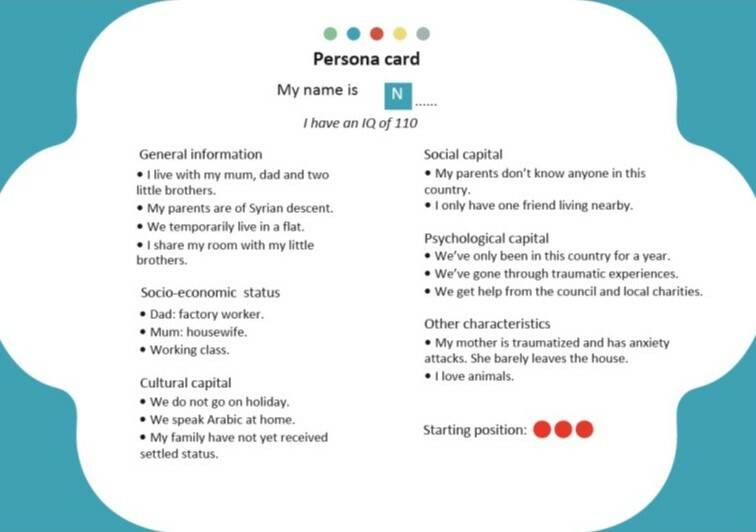
After each of the three to five payers have studied their personas and shared their key characteristics with their fellow players, in turn they draw a situation card. These situations have three possible outcomes, each resulting in getting green (positive) or red (negative) chips. For each situation the other players discuss the most likely scenario and thus determine the pupil’s score. This aspect of the game – witnessing how other people decide for you – is an important aspect of the simulation. Figure 2 shows a situation card. These cards and scores were informed by SES research as well as by the designers’ personal experiences as teachers (and sometimes as pupils).
Figure 2. A Sample of Situation Cards
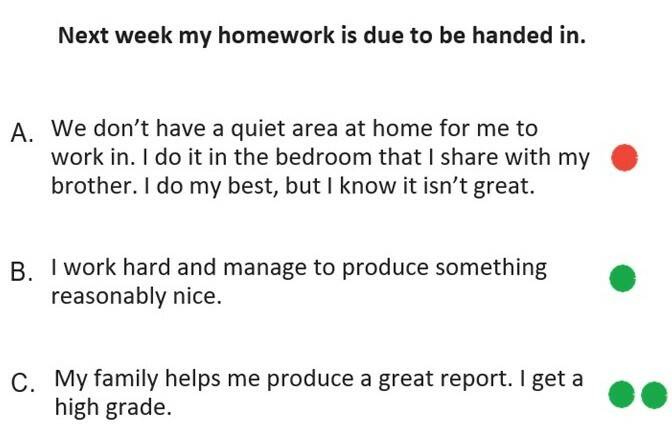
The game is played in three rounds: one round represents primary school experiences; one secondary school and finally a round that represents either higher education or work. The game ends with a discussion of the insights that playing brought about, prompted by the Follow-up cards that are provided. In addition, as a processing assignment, each of the players fill in a canvas, a form that records specific intentions and applications for their own workplace, as a form of self-imposed homework (see Figure 3).
Figure 3. Equal Opportunity Canvas
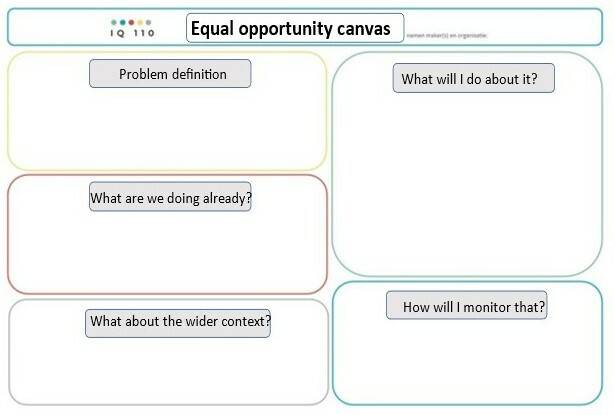
In the series of game sessions that were studied in this research project, these canvasses were discussed in small groups in a follow-up meeting, two to four weeks later, and followed by a group discussion. The game was played in a dozen different settings by a total of 90 people, all students at the Amsterdam University of Applied Sciences, either studying to become teachers in a bachelor programme or experienced teachers studying in a master’s programme (see Table 1 and Table 2). The project received ethics approval from the university’s committee, and informed consent was obtained from all participating students.
Table 1. Respondents’ Experience as a Teacher

Table 2. Respondents’ Work Placement and Years

The Conceptual Model
The intervention consisted of three parts: after a short introduction, the game was played (X1). Then, following a discussion of the experience, the players individually filled in a canvas (X2), which was discussed 2-4 weeks in a follow-up session (X3). The expectation was that that would lead to two interconnected outcomes. First, it was expected that playing the game and experiencing the effects of inequality of opportunity personally (Z1) would raise the players’ awareness, helping them to identify the problem of inequality of opportunity (Y1). Second, it was expected that the discussions that followed (in effect a collective reflection) – as well as the canvas exercise (an individual reflection) (Z2) would help the players actively think of ways to address the problem in their specific workplace and thus promote their self-efficacy (Y2).
Figure 4. Conceptual Model
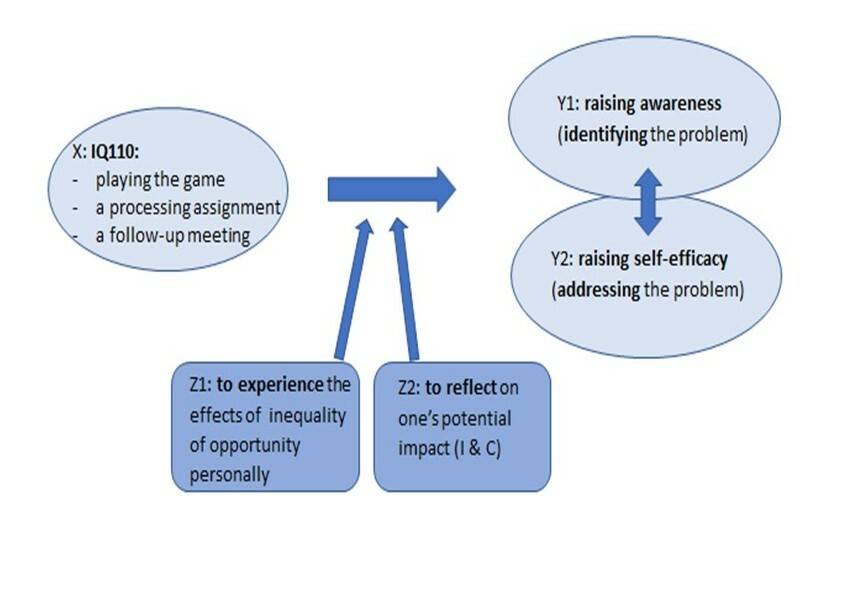
Method
The research questions with which the conceptual model was investigated are: To what extent and how does IQ110 affect teachers’ ability to identify and address inequality of opportunity? Three types of data were collected to research these questions:
(1) Retrospective pretest/posttest scores.
(2) Data from two open questions: (a) What is the most important outcome of this activity (that is, playing the game, the discussions and the follow-up assignment) and (b) What caused that outcome?
(3) Canvases were collected to study the kinds of activities the respondents might follow up on.
As for the pretest/posttest questionnaire, a problem with interventions that seek to raise awareness is that it can happen that respondents rate themselves lower in the posttest, because the intervention made them realise they knew less than they thought they did, a mechanism sometimes referred to as the Meno paradox (people do not know what they do not know) or the response-shift effect. In such cases a retrospective pretest/posttest design may be useful (Young & Kallemeyn, 2019). A retrospective pretest is administered at the same time as the posttest: immediately after the posttest, respondents are asked to think back to their understanding before the intervention, and this becomes the reference point to measure potential effects. A disadvantage of this type of questioning is that it might encourage the respondents to simulate a learning effect as that may seem the socially desirable response (Lamb, 2005). It means possible effects need to be put into perspective by associating them with the responses to the open questions. The pretest/posttest questionnaire was presented in statements that were scored on a 5-point Likert scale. The operationalization of the dimensions can be found in Table 3. The questionnaire was filled in digitally and anonymously.
Table 3. Operationalization Tables

Data Processing
First, the cluster consistency was tested by calculating the Cronbach’s alphas: varying between 0.7 and 0.9, the clusters were sufficiently consistent. Then the cluster averages (dimensions and subdimensions) were calculated, and t-tests were executed to see if the differences were significant, which they proved to be (p < 0.01). Then the effect sizes (or Cohen’s d) were calculated by dividing the differences between paired cluster scores by the (average) standard deviation of the pair, a procedure not uncommon in needs analyses (see e.g., Altschuld & Witkin, 1999). The standard deviation thus becomes a measure for differences between paired items. When qualifying these differences, as a rule of thumb, we used Baarda et al.’s (2012) suggestion that a Cohen’s d from around 0.5 should be considered an indication of a medium ‘effect’; a Cohen’s d higher than 0.8 can be considered high. Finally, the results were tested for the different groups of respondents (age groups; years of experience; school sectors). No significant differences were found (p < 0.05) between these groups.
As for the open question responses: these were first coded openly and then axially, so categories of answers could be constructed. The same applied to the canvas entries: the two relevant sections (Problem definition & What will I do about it?) were copied to a spreadsheet for this analysis. Both these analyses were carried out by two researchers independently, who then compared their findings. Where there were differences, there was a calibration. There were 90 respondents in total.
Results
Retrospective Pretest and Posttest
All sub-dimensions showed medium to large effect sizes. In the first cluster Raising Awareness (dimension Y1), Commitment (0.53) showed a medium effect; Sensitivity (0.84) and Awareness (1.03) showed high effects. In the second cluster Raising self-efficacy (dimension Y2), Behaviour/ Action (0.52) showed a medium effect; Self-efficacy/ skills (0.65); ‘Learning-to-learn’ (0.74) and Intentions (0.75) all showed medium-to-high effects, and Knowledge & insight (0.87) showed a high effect.
As for the effect sizes of the dimensions themselves (Y1 and Y2), these were determined by calculating the averages of the (averaged) sub-dimensions, divided by the standard deviations of these averaged sub-dimensions. Both Y1 – Raising awareness (0.90) and Y2 – Raising self-efficacy (0.88) showed high effects.
Judging from these results, the hypothesis, visualized in the conceptual model (see Figure 4), seems to be supported, with the proviso of the very real limitations of a retrospective pretest/posttest design. These limitations include the risk of some respondents feeling invited to score higher on the posttest than on the pretest. If they believe (or feel encouraged to state) that a change has occurred, it will necessarily be a whole point difference on the scale – resulting in high effect sizes. It means that the quantitative data are less accurate than the numbers in the table suggest. They should rather be treated like indications. In that sense the qualitative data are more suitable to test the hypothesis.
Table 4. Effect Sizes Retrospective Pretest/Posttest (n=90)

The open questions
The questionnaire contained two open questions: What is the most important outcome of this activity (that is, playing the game, the discussions and the follow-up assignment) and What caused that outcome? In Tables 5 and 6 the clusters of replies are presented, in order of descending frequency. In line with the quantitative data, both awareness (I; V; VI) and self-efficacy (II; III; IV; VII; VIII; IX) were convincingly reported outcomes, although relatively few replies referred to concrete actions (VII; VIII).
Table 5. The Reported Outcomes of the Activity

The second open question (What caused that outcome?) was asked to get more insights into the mechanisms that drive the game. In Table 6 the clusters of replies are presented, again in order of descending frequency. Many replies could be fitted under more than one cluster (for instance the very first example in Table 6), which explains that the total number of replies (the added frequencies) exceeds the number of respondents.
We had hypothesized (see the conceptual model in Figure 4) two mechanisms: that to experience the effects of inequality of opportunity personally (Z1) and to reflect on one’s potential personal impact as a teacher, both individually and collectively (Z2), would lead to the intended outcomes. Both of these mechanisms are largely represented in the replies, although sometimes the replies were formulated too generally to really identify the mechanism. A mechanism not anticipated was the acquisition of knowledge or the transfer of information (cluster VI.), although it could be argued that such acquisition would imply some form of individual reflection.
Table 6. The reported causes of the outcomes
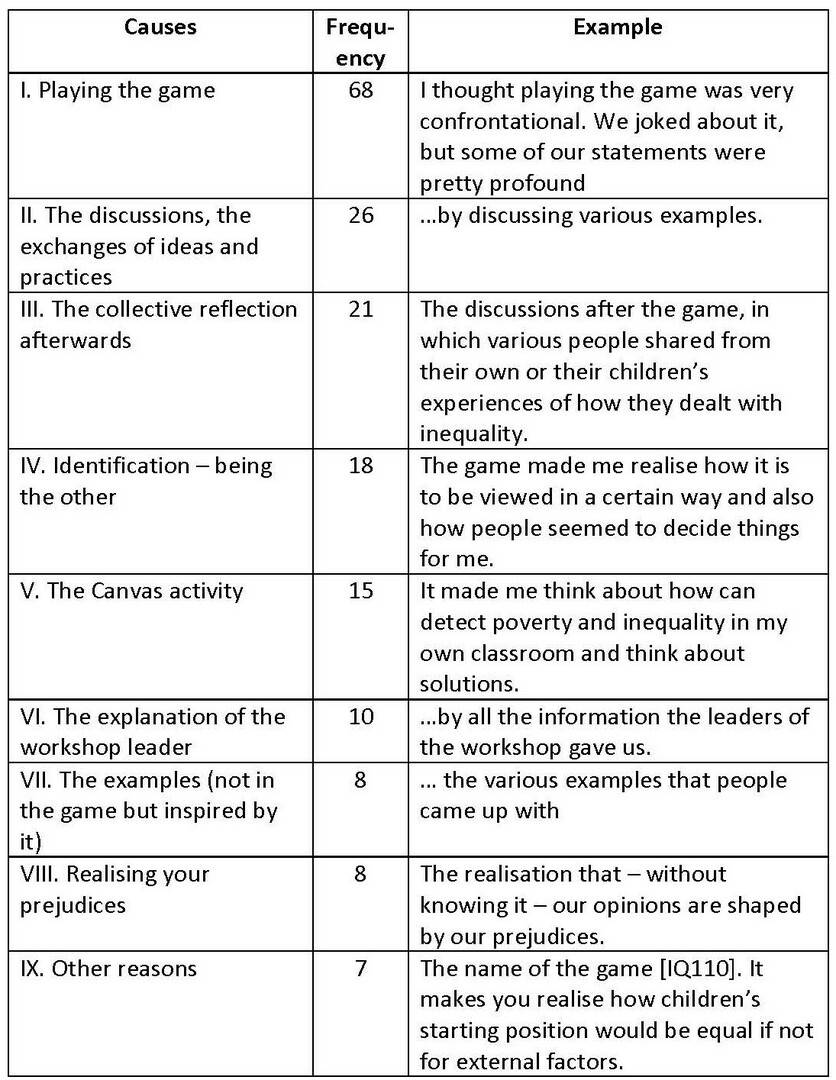
The canvasses
The third and last instrument were the canvasses that respondents were asked to create to direct and monitor their own (potential) activities. These data offer indications of the eventual effects the intervention could have. Not all players chose to participate in this part of the project: out of the 90 that filled in the questionnaires, 66 identified a theme; a problem they would like to address in their workplace. 61 of these also reported in what way they would do this.
The replies showed much variation. Twenty-seven different (types of) problems were identified. In Table 7 below only those that were mentioned by four or more respondents are recorded. The most frequently mentioned theme (by far) relates to socio-economic status, maybe because it is more obvious, more easily identifiable than cultural, social and psychological capital (the persona cards also mentioned these forms of capital). In the responses on proposed actions (see Table 8), what stands out is that many of these are aimed at creating more awareness – both personally and for colleagues. It suggests that the game started the process of awareness but leaves room for more of it – not only to share with colleagues (which would be expected), but also to further promote one’s own awareness. This corresponds with the project’s ambition of putting inequality of opportunity (back) on the agenda of teachers.
Table 7. Reported Problems to Address (Canvas)
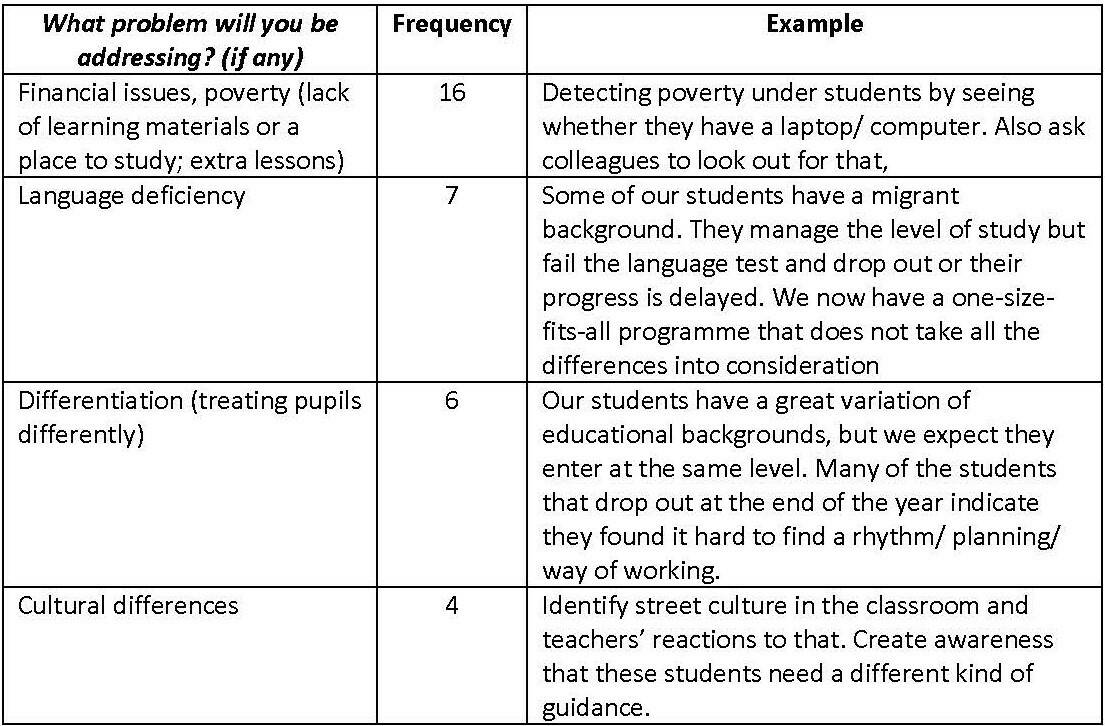
Table 8. Reported Actions (Canvas)
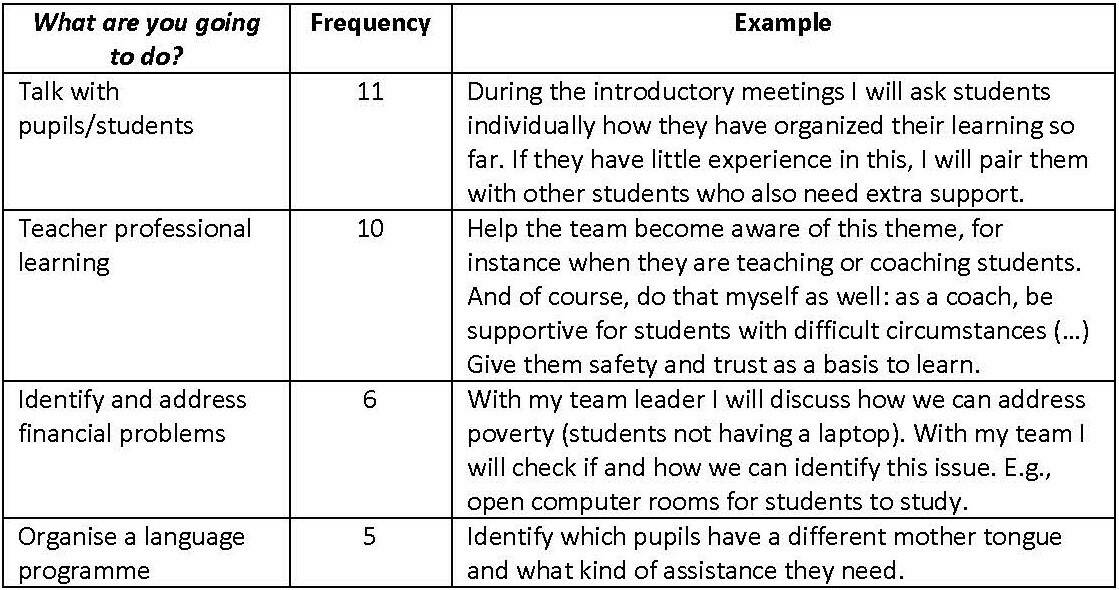
Conclusions: Implications and Applications
It is important for teachers to develop critical awareness of the oft hidden mechanisms behind inequality of opportunity, and to find strategies that can compensate for these mechanisms, to support all children to fulfill their potential. Of course, such ambitions cannot be achieved by only having teachers play a game. Having said that, the data presented in this paper do suggest that IQ110 (‘an exceptionally unfair game’) helps teachers to at least make a start with generating critical awareness. The hypothesis, visualized in the conceptual model (see fig. 4), is supported by the data generated by all three instruments. The majority of the respondents reported to have grown in terms of awareness and self-efficacy, and many of them gave concrete examples of the kinds of follow-up actions they envision. They attributed their learning results to having played the game, including the exchanges and collective reflections, as well as the process of identification, and this is in line with what was found in the literature (see Zainuddin et al., 2020).
Some of the direct consequences of this project are that a number of the programs or course units with which students were involved have decided to include the game in their curricula. This was not just because of the impact of this specific project, but also because for some it was their first experience with serious gaming, and this experience was a positive one, especially in terms of its potential to engage the participants (see Foster & Shah, 2020). Some students (who were also experienced teachers) planned to play the game with their workplace colleagues.
On a more abstract level, this project could be used as an argument to put inequality of opportunity more firmly on the agenda of teacher training programmes or programmes aimed at teacher professional learning. Playing the game could serve as a good starting point for this. Also, the results suggest that (serious) game-based learning could be a suitable tool to help teachers develop complex attributes that require personal experiences and deep reflection, such as sensitivity, multi-perspectivity and agency (see Goei et al., 2021). The idea of persona cards being used as lenses to look in various ways at various situations seems a promising one. It would be interesting to further research its potential in other contexts that require invoking multi-perspectivity.
Note. The research project presented in this paper was conducted in the Netherlands and was based on a Dutch version of the game. The design group have since developed an international, English language version of the game and welcomes invitations to share the materials with you.
References
Altschuld, J. W. & Witkin, B. R. (1999). From Needs Assessment to Action: Transforming Needs Into Solution Strategies. Thousand Oaks, Calif.: Sage Publications, Inc.
Baarda, B., Bakker, E., Hulst, M. van der, Julsing, M., Fischer, T. Vianen, R. van & Goede, M. de (2012). Basisboek Methoden en Technieken. Kwantitatief praktijkgericht onderzoek op wetenschappelijke basis. Groningen/ Houten: Noordhoff Uitgevers.
Benzeval, Bond, L., Campbell, M., Egan, M., Lorenc, T., Petticrew, M., & Popham, F. (2014). How does money influence health? Joseph Rowntree Foundation.
Bernstein, B. (1970). Education cannot compensate for society. New Society, 15, 387. Retrieved from https://www.proquest.com/magazines/education-cannot-compensate-society/docview/1307084896/se-2?accountid=14511
Bourdieu, P. (1986). The Forms of Capital. In J. R. (Ed.), Handbook of Theory and Research for the Sociology of Education (pp. 241-258.). New York: Greenwood.
Bourdieu, P. (1990). The Logic of Practice. Cambridge: Polity Press.
Cobb, J. S. (2017). Inequality Frames: How Teachers Inhabit Color-blind Ideology. Sociology of Education, 90(4), 315–332. https://doi.org/10.1177/0038040717739612
Downey, D. B., von Hippel, P. T., & Broh, B. A. (2004). Are Schools the Great Equalizer? Cognitive Inequality during the Summer Months and the School Year. American Sociological Review, 69(5), 613–635. http://www.jstor.org/stable/359303
Dutch Inspectorate; Inspectie van het Onderwijs (2021). De Staat van het Onderwijs 2021. Utrecht: Inspectie van het Onderwijs.
Edwards, R., Gillies, V., & White, S. (2019). Introduction: Adverse Childhood Experiences (ACES) – Implications and Challenges. Social Policy and Society : a Journal of the Social Policy Association, 18(3), 411–414. https://doi.org/10.1017/S1474746419000137
Elffers, L. (2022). Onderwijs maakt het verschil. Kansenongelijkheid in het Nederlandse onderwijs. Walburgpers.
Elffers, L. (2019). De opkomst van schaduwonderwijs in Nederland: wat weten we en welke vragen liggen nog open? Universiteit van Amsterdam, Amsterdam.
European Commission. (2020). Education and Training monitor. Retrieved from https://op.europa.eu/webpub/eac/education-and-training-monitor-2021/downloads/2020-3429%20-%20Monitor%202020.pdf
Eurostat. (2021). Migrant integration statistics. Luxembourg: Statistical Books, European Commission.
Faiella, F. & Ricciardi, M. (2015). Gamification and learning: a review of issues and research. Je-LKS, 11(3). https://doi.org/10.20368/1971-8829/1072
Foster, A. & Shah, M. (2020) Principles for Advancing Game-Based Learning in Teacher Education, Journal of Digital Learning in Teacher Education, 36(2), 84-95, DOI: 10.1080/21532974.2019.1695553
Goei, S. L., Willemse, M., Kaskens, J., Ridder, M., Boei, F., & Hamer, T. (2021). Beelden en praktijken van lerarenopleiders over inclusief opleiden. In Kansen(on)gelijkheid in het onderwijs (Vol. 4, pp. 32–44). VELON/ VELOV.
Harker, R. & May, S. A. (1993). Code and Habitus: comparing the accounts of Bernstein and Bourdieu. British Journal of Sociology of Education, 14(2), 169–178. https://doi.org/10.1080/0142569930140204
Jansen, D., Elffers, L. & Jak, S. (2021). A cross-national exploration of shadow education use by high and low SES families. International Studies in Sociology of Education, DOI: 10.1080/09620214.2021.1880332
Keep, E. & Mayhew, K. (2014). Inequality – ‘wicked problems’, labour market outcomes and the search for silver bullets. Oxford Review of Education, 40:6, 764-781, doi:10.1080/03054985.2014.979580
Koivisto, J., & Hamari, J. (2019). The rise of motivational information systems: A review of gamification research. International Journal of Information Management, 45, 191–210. https://doi.org/10.1016/j.ijinfomgt.2018.10.013
Lamb, T. (2005). The Retrospective Pretest: An Imperfect but Useful Tool. The Evaluation Exchange, XI15(2 ), 18. Retrieved from https://archive.globalfrp.org/evaluation/the-evaluation-exchange/issue-archive/evaluation-methodology/the-retrospective-pretest-an-imperfect-but-useful-tool
OECD. (2022). Income inequality (indicator). doi: 10.1787/459aa7f1-en (Accessed on 21 April 2022).
Onderwijsraad. (2021). Advies Later selecteren, beter differentiëren.
Oplatka, I., & Gamerman, O. (2021). Compassion in Urban Teaching: Process, Arenas, and Factors. Urban Education (Beverly Hills, Calif.), 56(2), 318–343. https://doi.org/10.1177/0042085916685765
Pavett, D. (2014). Compensating for society – what did Bernstein actually say? Retrieved from https://educevery.wordpress.com/2014/04/28/compensating-for-society-what-did-bernstein-actually-say/
Reay, D. (2011). Schooling for democracy: a common school and a common university? A Response to “Schooling for Democracy.” Democracy & Education, 19(1).
SER. (2021). Gelijke kansen in het onderwijs. Structureel investeren in kansengelijkheid voor iedereen. Retrieved from https://www.ser.nl/-/media/ser/downloads/adviezen/2021/gelijke-kansen-in-onderwijs.pdf?la=nl&hash=0E1EF49F994094D96BA36A5FDC6E200B
Young, J., & Kallemeyn, L. (2019). Testing the Retrospective Pretest with High School Youth in Out-of-School Time Programs. Journal of Youth Development (Online), 14(1), 216–229. https://doi.org/10.5195/jyd.2019.635
Young, M.D. (1958). The Rise of the Meritocracy, 1870-2033: An Essay on Education and Quality. Londen: Thames and Hudson.
Zainuddin, Z., Chu, S. K. W., Shujahat, M., & Perera, C. J. (2020). The impact of gamification on learning and instruction: A systematic review of empirical evidence. Educational Research Review, 30, 100326. https://doi.org/10.1016/j.edurev.2020.100326
To cite this work, please use the following reference:
Koffeman, A., Snijders-Blok, D., Stavenga, W., Rusbach, B., & Meelker, J. (2024, March 12). Supporting teachers to identify and address inequality of opportunity by playing a serious game. Social Publishers Foundation. https://www.socialpublishersfoundation.org/knowledge_base/supporting-teachers-to-identify-and-address-inequality-of-opportunity-by-playing-a-serious-game/
